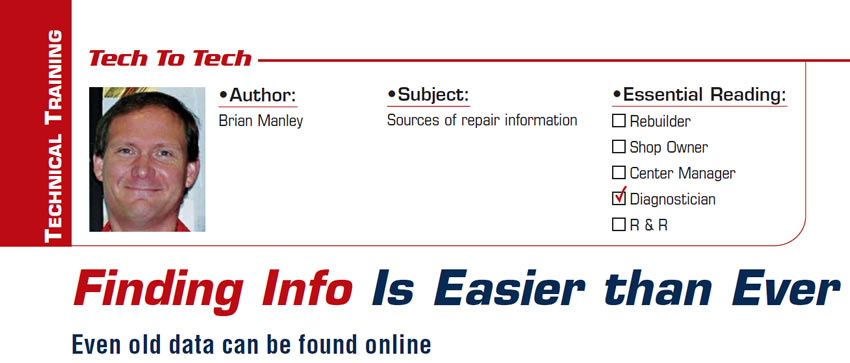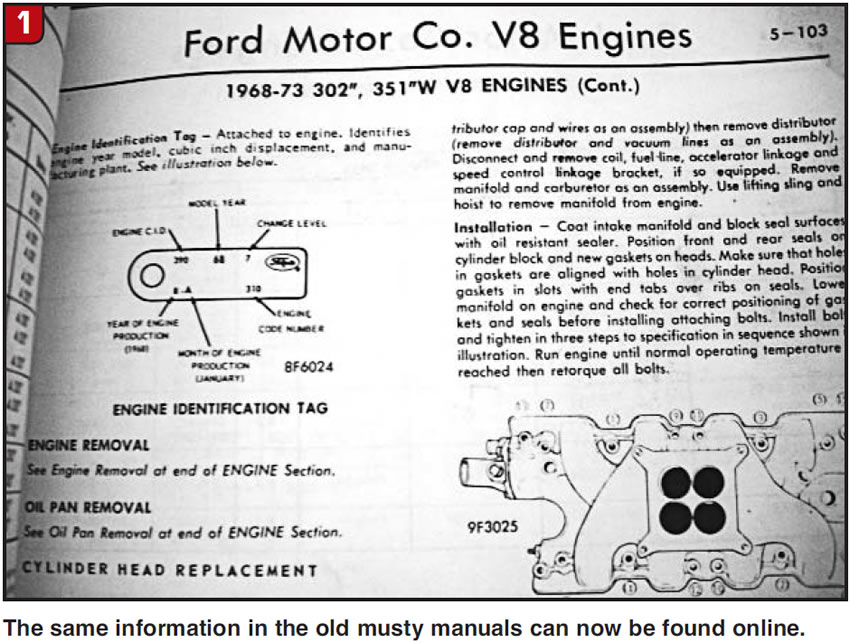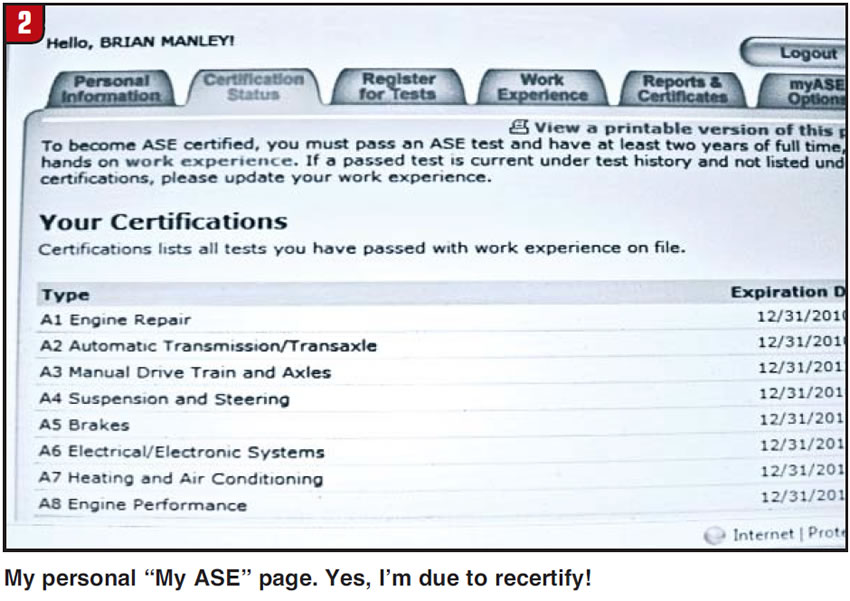
Tech to Tech
- Subject: Sources of repair information
- Essential Reading: Diagnostician
- Author: Brian Manley
Even old data can be found online
I have noticed lately that many familiar sources of information have some amazing features that allow us to save diagnostic time, as well as space on our bookshelves.
Information sources go “vintage”
We all have at our fingertips a computer-based repair-information resource, but when a pre-1982 vehicle becomes one of your new repair jobs, where do you go for the repair information?
Recently, when an older vehicle – a 1967 Ford Mustang – rolled into our shop I first reached for my 35-year-old, five-inch thick, plastic-bound repair manual while looking for service information. I then remembered seeing the “Vintage” tab on the menu of my online information system. As I began comparing the pages in the book to the information on the computer, I noticed they were identical. This online resource gives the same information for imports as well. Unlike the book format, I can print, highlight and pass on information from this source. If you need to see how an old-school, external voltage regulator is wired on a 1968 Corona, or you just can’t wait to replace that timing belt on that 1973 Vega, you’ve got the information online!

Many shops are “paperless” these days, and I wonder how many old books are stored in back rooms and attics across the globe. Does this mean I’ll be throwing away my old, thick, greasy, musty repair manuals? No way! I have friends who have tossed their printed versions of this information in lieu of its electronic counterpart, but I just can’t bring myself to do it. I have a series of repair manuals that goes back to the 1940s; how cool is that?
www.iatn.net for manufacturer training online
Want to brush up on your electrical theory? Want a quick course on Toyota hybrid systems? If you are a member of the International Automotive Technicians Network (iATN), then you probably search help requests for diagnostic help, and you probably share your own wisdom and experiences with the group. If you spend some free time and click on the “Resources” tab, you will find manufacturer training from General Motors Co., Ford Motor Co. and Toyota Motor Corp. Years ago, I attended the weeklong Specialized Electronics Training (SET) at our regional GM Training Center, and it contained a lot of information. At the time, the course came in a paperbacked-manual format. The cool thing is that the entire course is now on iATN in sequence, just as it was taught to me. This course used their SET electrical trainers – the same ones we have in our automotive training facility – and we train other young techs using this GM resource.
The GM tab also includes General Motors Onboard Diagnostics – Generation II class, which is the place to go to refresh your GM misfire-diagnosis training, enhanced evaporative-systems theory, or relearn their Strategy-Based Diagnostics model.
If you’re having trouble with Ford’s passive antitheft system (PATS), you can learn that system strategy and discover all of their parameter IDs (PIDs).
While we’re under the iATN umbrella, how often do you visit the National Automotive Service Task Force (NASTF) link under the “resources” tab? I have spent some time on the Toyota/Lexus Web site for training, and it is pretty cool to be able to access this OEM training and information. This Toyota training is the same as the series used to train the new dealer technicians and provide new-model information as well. This link can also guide you to each manufacturer’s Web site and will show what training or information is available for each. If you specialize in a particular vehicle brand, then it may be worth your while to invest in the manufacturer information.
Sit down and explore this site, and I think you’ll agree it has value as a training resource. The “Online Test” section can aid in brushing up on electrical theory as well as scan-tool diagnosis. This can be a good prep for any automotive testing you may have ahead of you.
The “A-6 ASE Electrical Test Prep” section is a great way to determine whether you’re ready for the test or if you need extra study time. This interactive format is fun and helpful. You can always purchase study guides later if needed.
There is a lot of Toyota-specific content here, but much of the theory is universal.
If you haven’t been into the ASE site lately, I recommend you get in there and root around. A while back, I registered for the “My ASE” feature, and I can view my certification history, register for tests and purchase score reports and certificates (in case my dog eats mine). I have used this service to print out my history of certifications for my job portfolio.

Under the “Service Professionals” tab, you can access the official ASE practice tests. The questions will be in the same format as the real test questions, and they will provide you with a score report and have explanations for each question. How many times have you gone into an ASE test sweating just a little bit?
Last year, ASE also launched an online maintenance and inspection program, which contains four modules and a final quiz. This training is geared toward entry-level technicians whose primary responsibility is vehicle maintenance. I have been in this training and it is well-structured with good pictures and explanations. A technician who successfully passes this training will not receive an ASE certification, but a certificate of recognition. This training can, however, be a stepping stone to achieving ASE certification.
As an instructor and a technician, I am constantly finding new resources online to help me solve a tough repair, prepare for an exam or study an unfamiliar vehicle system. If you are like me, you often spend your lunch wherever the computer is, taking advantage of online face time in order to stay on top of your many responsibilities.

Brian Manley is a vocational automotive instructor for the Cherry Creek school district in Aurora, Colo. He is an ASE master certified automobile technician and a former member of the National Automotive Technicians Education Foundation (NATEF) board of trustees. You can reach him at [email protected].
This copyrighted article is reprinted with the permission of AutoInc., the official publication of the Automotive Service Association (ASA). To learn more about ASA and its commitment to independent automotive service and repair professionals, visit www.ASAshop.org or call (800) 272-7467.













